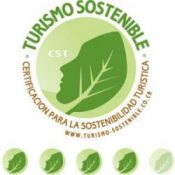The White-nosed Coati (Nasua narica), also known as the Pizote, is a species of coati and a member of the Procyonidae (raccoon family) and is commonly seen in Costa Rica. With Bahia Aventuras you can see the White-nosed Coati during your Corcovado National Park full day tour.
White-nosed Coatis inhabit wooded areas (dry and moist forests) of the Osa Peninsula and Corcovado Park. They are found at any altitude from sea level to 3,500 m (11,000 ft). They are omnivores, preferring small vertebrates, fruits, carrion, insects, and eggs. They can climb trees easily, where the tail is used for balance, but they are most often on the ground foraging. Their predators include boas, raptors and hunting cats like the jaguar and puma that inhabit the Corcovado National. They readily adapt to human presence; like Raccoons, they will raid campsites and trash receptacles. They can be domesticated easily, and have been verified to be quite intelligent.
White-nosed Coatis are primarily diurnal, retiring during the night to a specific tree and descending at dawn to begin their daily search for food. Adult males are solitary, but females and sexually immature males form social groups. They use many vocal signals to communicate with one another, and on our tours you might hear them. They also spend time grooming themselves and each other with their teeth and claws.
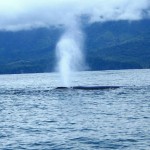 The humpback whale (Megaptera novaeangliae) is a Baleen whale. One of the larger rorqual species, adults range in length from 12-16 metres (40-50 ft) and weigh approximately 36,000 kilograms (79,000 lb). The humpback has a distinctive body shape, with unusually long pectoral fins and a knobbly head. It is an acrobatic animal, often breaching and slapping the water. Males produce a complex whale song, which lasts for 10 to 20 minutes and is repeated for hours at a time. The purpose of the song is not yet clear, although it appears to have a role in mating.
The humpback whale (Megaptera novaeangliae) is a Baleen whale. One of the larger rorqual species, adults range in length from 12-16 metres (40-50 ft) and weigh approximately 36,000 kilograms (79,000 lb). The humpback has a distinctive body shape, with unusually long pectoral fins and a knobbly head. It is an acrobatic animal, often breaching and slapping the water. Males produce a complex whale song, which lasts for 10 to 20 minutes and is repeated for hours at a time. The purpose of the song is not yet clear, although it appears to have a role in mating.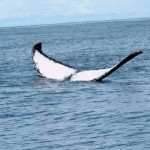 About 2/3 of the way back on the body is an irregularly shaped dorsal (top) fin. Its flippers are very long, between 1/4 and 1/3 the length of its body, and have large knobs on the leading edge. The flukes (tail), which can be 18 feet (5.5 m) wide, is serrated and pointed at the tips. Adult males measure 40-48 feet (12.2-14.6 m), adult females measure 45-50 feet (13.7-15.2 m). They weigh 25 to 40 tons (22,680-36,287 kg).
About 2/3 of the way back on the body is an irregularly shaped dorsal (top) fin. Its flippers are very long, between 1/4 and 1/3 the length of its body, and have large knobs on the leading edge. The flukes (tail), which can be 18 feet (5.5 m) wide, is serrated and pointed at the tips. Adult males measure 40-48 feet (12.2-14.6 m), adult females measure 45-50 feet (13.7-15.2 m). They weigh 25 to 40 tons (22,680-36,287 kg).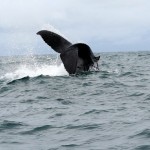
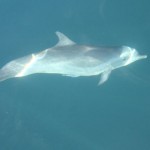 The bottlenose dolphin is perhaps one of the most well known cetaceans, because of its widespread use in marine parks and research facilities. The bottlenose dolphin may be best known as “Flipper” from the television series. In Costa Rica, during
The bottlenose dolphin is perhaps one of the most well known cetaceans, because of its widespread use in marine parks and research facilities. The bottlenose dolphin may be best known as “Flipper” from the television series. In Costa Rica, during 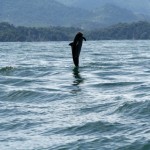 Natural histroy of bottlenose dolphins
Natural histroy of bottlenose dolphins 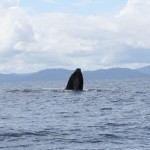
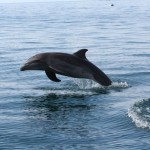
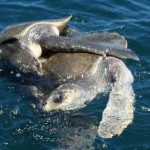
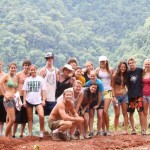 Bahia Aventuras has started organizing plans to host several student travel groups for the summer of 2010 in Uvita-Bahia Ballena.
Bahia Aventuras has started organizing plans to host several student travel groups for the summer of 2010 in Uvita-Bahia Ballena.  will work closely with community members on small-scale construction, environmental, and social projects that will contribute to community’s economic development. By working alongside community members the students will immerse in the flow of life in the friendly beach town of Uvita-Bahia Ballena and learn about the culture of PURA VIDA! Radical sunsets, beaches lined with palm trees, crystal clear blue water, and friendly locals all contribute to a great week for the students in Uvita-Bahia Ballena.
will work closely with community members on small-scale construction, environmental, and social projects that will contribute to community’s economic development. By working alongside community members the students will immerse in the flow of life in the friendly beach town of Uvita-Bahia Ballena and learn about the culture of PURA VIDA! Radical sunsets, beaches lined with palm trees, crystal clear blue water, and friendly locals all contribute to a great week for the students in Uvita-Bahia Ballena. They were charged with the mission of helping a business in Costa Rica become profitable while having a positive impact on people and the planet. That business was Bahia Aventuras.
They were charged with the mission of helping a business in Costa Rica become profitable while having a positive impact on people and the planet. That business was Bahia Aventuras.
